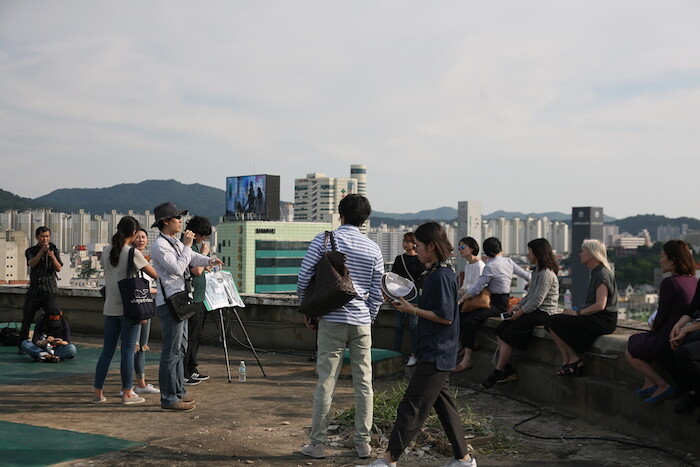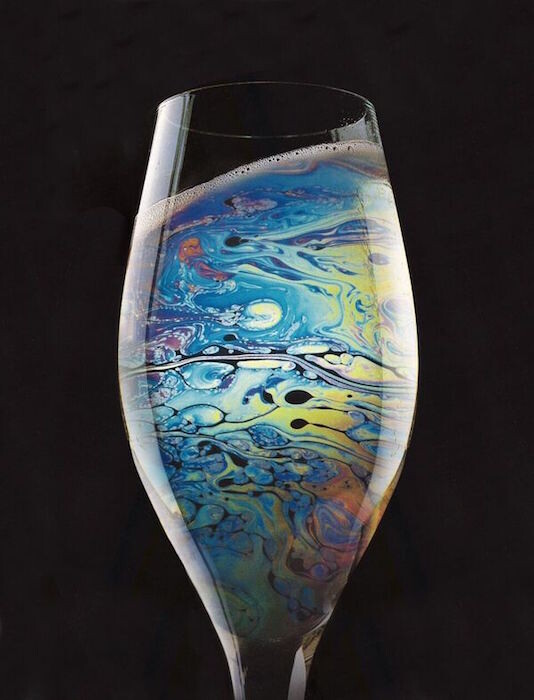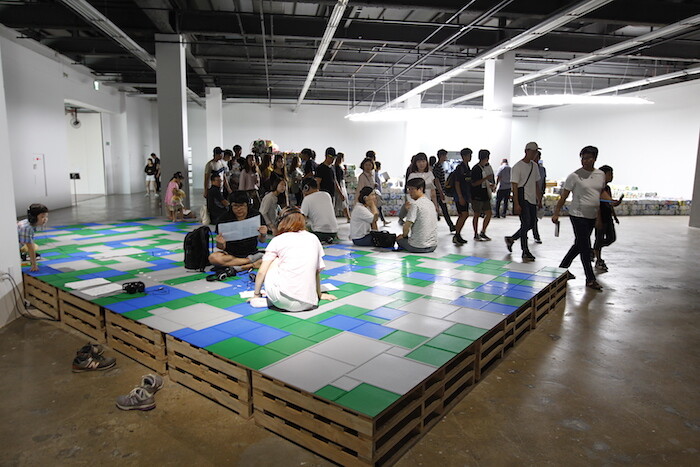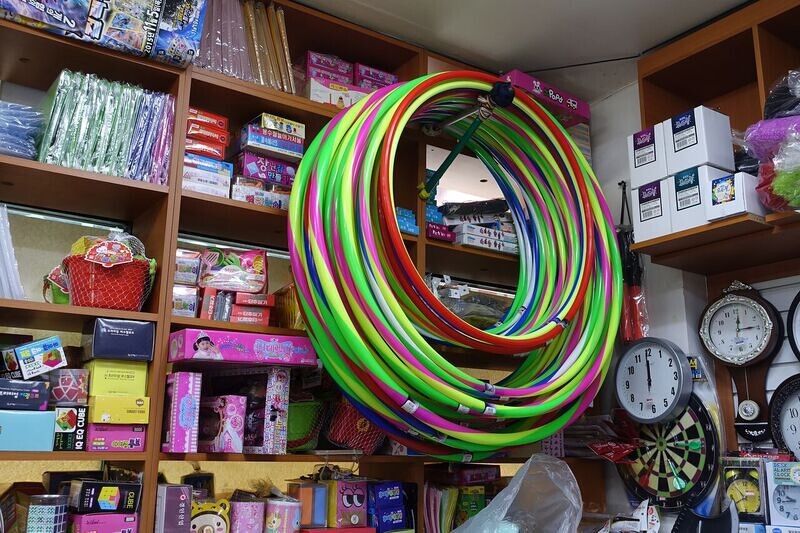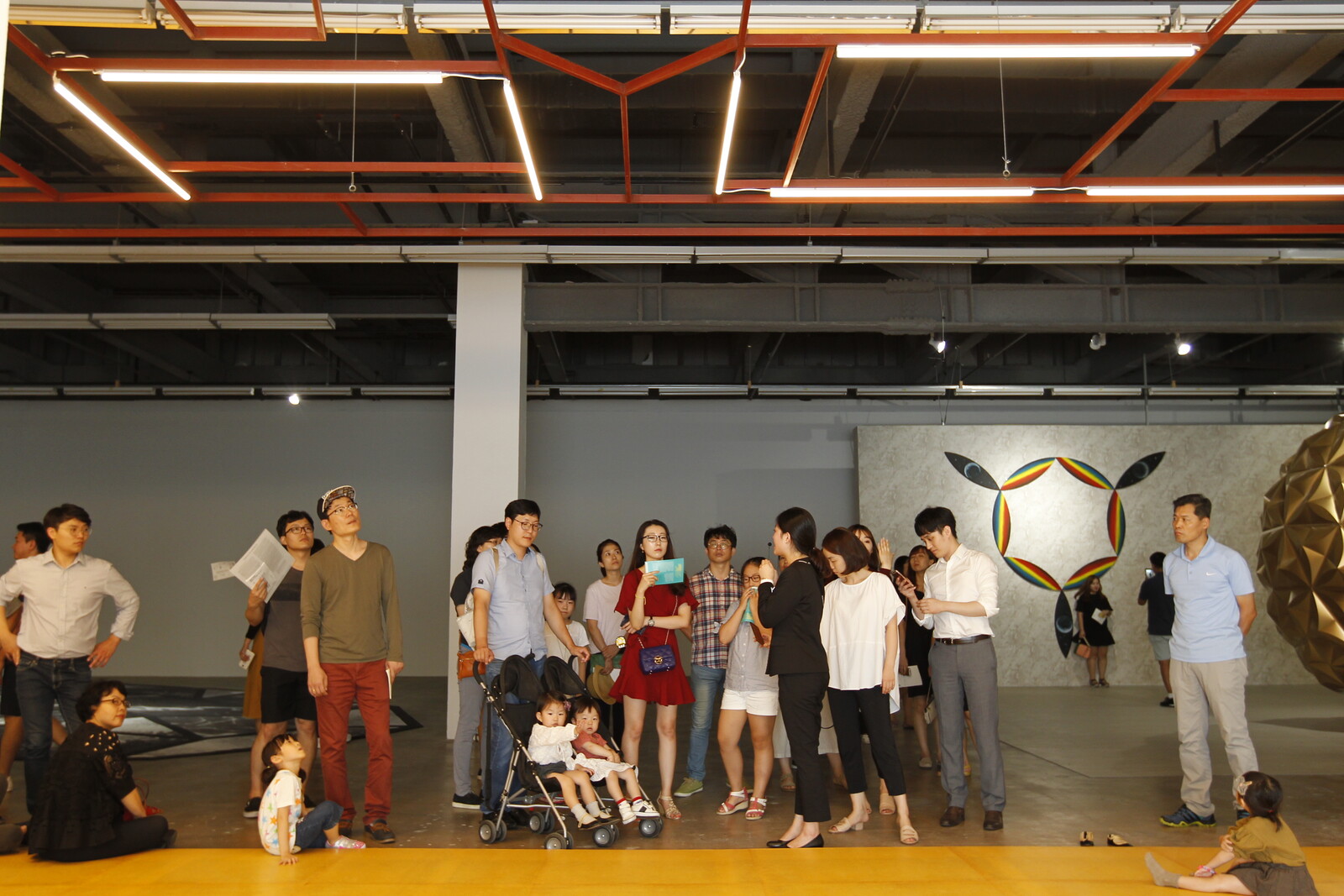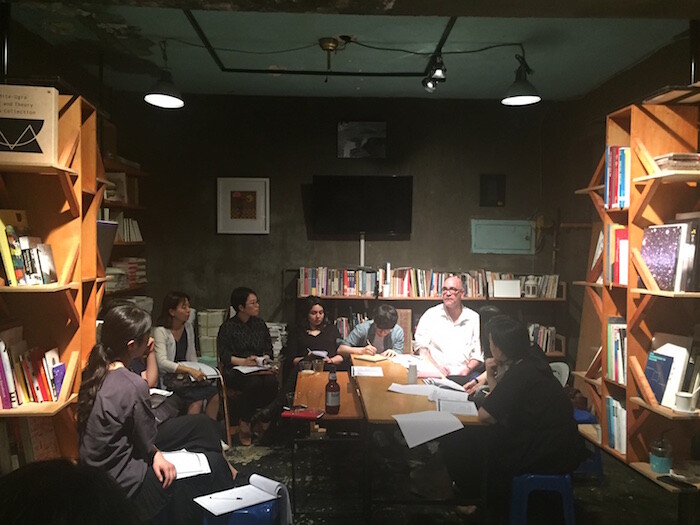September 2–November 6, 2016
Hanging right inside the main entrance in Gallery 1, facing incoming visitors, Agnieszka Polska’s Glass of Petrol (2015) is the one work that cannot be missed at the 11th Gwangju Biennale. Depicting a champagne flute filled with shiny gasoline, the colorfulness of which resembles that of Planet Earth, Polska’s digital print hints at humanity’s dependence on oil and opens the Biennale with the image of a world in crisis. The work provides a visual and socio-political backdrop for the question imposed by the curatorial team1: “What Does Art Do?”
The other half of the title, “The Eighth Climate,” refers to a concept originating in twelfth-century Persian philosophy: a zone between the material and immaterial, it is both real and imaginal (as distinct from imaginary), resembling the realm of contemporary art. Under this all-encompassing curatorial concept, GB11 features work by 101 artists, including 28 new commissions.
At the center of Gallery 1 is Dora García’s reconstruction of Gwangju’s historic Nokdu Bookstore, said to have fostered the May 18 Democratic Uprising in 1980. Nokdu bookstore for the living and the dead (2016) functions as a real bookstore co-operated by Seoul’s The Book Society. Relevant publications and civilian objects are sold or displayed in and around this semi-open wooden structure. García’s work creates a public space within another one, evoking thoughts about the art institution’s role and potential in society, thus testing “what art does.” There is an enthralling parallel between the new Nokdu Bookstore and Annie Lai Kuen Wan’s little kiosk Everyday A Rainbow (2016) outside the Exhibition Hall, where she arranges commodities collected from six shops in the surrounding neighborhood. Celadon replicas of the original objects are placed back in the original objects’ spots in the shops. Both works embody art’s capacity to make contact and foster “shared concerns”—the mediating role emphasized by Artistic Director Maria Lind.
One of most debatable aspects of GB11 is the spatial layout of the Exhibition Hall. Beyond Gallery 1, the artworks share space according to their medium or formal qualities. Gallery 2 is a dark environment housing works that emit light, namely, projected video, slides, and three of Anicka Yi’s installations (Fontanelle, 2015; Home in 30 Days, Don’t Wash, 2015; We are Water, 2015). Gallery 4 is dedicated to works responding to “the right to opacity”—one of the thematic “stands” in the show. The impression one gets entering the space is not unlike that of entering a modernism-inspired gallery group show. In fact, not only formal but also the political and socio-economical abstractions that are partially responsible for a world in crisis are at issue here, but one wonders whether those discussions would be more influential if surrounded by works sharing discourse rather than appearance. Lawrence Abu Hamdan’s crucial sound testament of systematic state brutality (Rubber Coated Steel, 2016) feels abrupt among peaceful formalist sculptures, and Monir Shahroudy Farmanfarmaian’s ravishing glass mosaic panels (Group 9 (Convertible Series), 2010; Decagon (The Second Family), 2011; Hexagon (Fifth Family), 2014; Square (Fifth Family), 2014) would seem less decorative if dialogues involving relevant histories or cultures were encouraged in the shared space.
Video pieces are among the strongest works in the latter two thirds of the exhibition—not because of the proliferation of the medium, but because video has become an “expediency” of many artists whose practice cannot be reduced to, or categorized by, its formal aspects. Lili Reynaud-Dewar’s Teeth, Gums, Machines, Future, Society (2016) was shot during her field trips to Memphis, Tennessee where she performatively investigates issues of race, class, the burden of city’s musical heritage, and the future through the prism of “grillz” (metal jewelry worn over the teeth) as a subcultural bodily representation. Barbora Kleinhamplová and Tereza Stejskalová’s Sleepers. A three-act play with six actors (2014) documents a collaborative absurd theater piece in which characters protest against sleep deprivation as a social phenomenon. Both works manifest the “imaginative perspective” and “visionary knowledge” anticipated of all artworks by the curatorial statement, and the same can be said of video works and installations by Bona Park, Nicholas Mangan, and Ane Hjort Guttu with Daisuke Kosugi. These process-oriented and/or research-based works would, however, benefit significantly from a short description on the wall text, which as it is only displays basic information plus a QR code I see barely any visitor scan.
Like Kassel, few art people would visit Gwangju if not for the biennale. Though the opening weekend is filled with “lost in translation” moments, I still wonder how much Korea’s sixth largest city, home of the national democracy movement, is seen or talked about by “the foreigners who show up every two years”? Artists who come to the city might consider not only “what does art do?” but also “what does a biennale do?” Some of the off-site—or “outer-venue” as the guidebook calls them—projects thoughtfully offer a glimpse of the city for the art tourists. Since the spring, Apolonija Šušteršič and Dari Bae have been working with residents of the Duam-dong neighborhood, on Gwangju’s outskirts, towards building a gathering and negotiating tradition at Nuribom Community Center (Master Plan for Duam-dong, 2016). Eyal Weizmann’s Roundabout Revolution (2013) is a spatially integrated memorial aiming to juxtapose the city’s proud past with ongoing global protests for a brighter future. Put together by curator Binna Choi, a mini exhibition of work by Christian Nyampeta, Cooperativa Cráter Invertido, and Jasmina Metwaly & Philip Rizk inside the 5.18 Archives on Geumnam-ro creatively interacts with histories of democratic movements and should not be missed.
The curatorial team also contemplate the question “what does a Biennale do?” within a larger industrial ecology. On the opening day, a forum entitled “To All the Contributing Factors” gathers and salutes roughly 100 “small- and medium- scale” art organizations, or “fellows” from all over the world which GB11 considers are not sufficiently valued by the mainstream art world.2 GB11’s “local curatorial associate,” the artist cooperative Mite-Ugro, coordinates Monthly Gatherings at its project space inside the local Daein Market. Additionally, an Infra-School (consisting of lectures, presentations, discussions, and seminars by artists and curators) has toured Korean universities and art schools since the end of last year. This intricate constellation of programs and events can be regarded as the most insightful effort of GB11.
What revealed itself at the Exhibition Hall on September 2 is only one fragment of this temporally and spatially extended biennale, many of whose actors and activators are not immediately visible. These include those who buy books from the reincarnated Nokdu Bookstore, those who use wifi signal generated from Trevor Paglen ’s encrypted router in Gallery 1, Guam-dong residents who have expressed problems with their living conditions, market-goers who have encountered the Monthly Gathering during one of its reading group sessions, and many others who have been and will be either voluntarily involved or accidentally swept in to the biennale. GB11 does not answer the question “what does art do?,” but leaves it purposefully open-ended.
The team comprises artistic director Maria Lind, curator Binna Choi, assistant curators Azar Mahmoudian, Margarida Mendes, Michelle Wong, and local curatorial associate Mite-Ugro.
However, the forum could have be more loosely curated. The traditional speaker-after-speaker format is unsuited to the subjects and participants.

